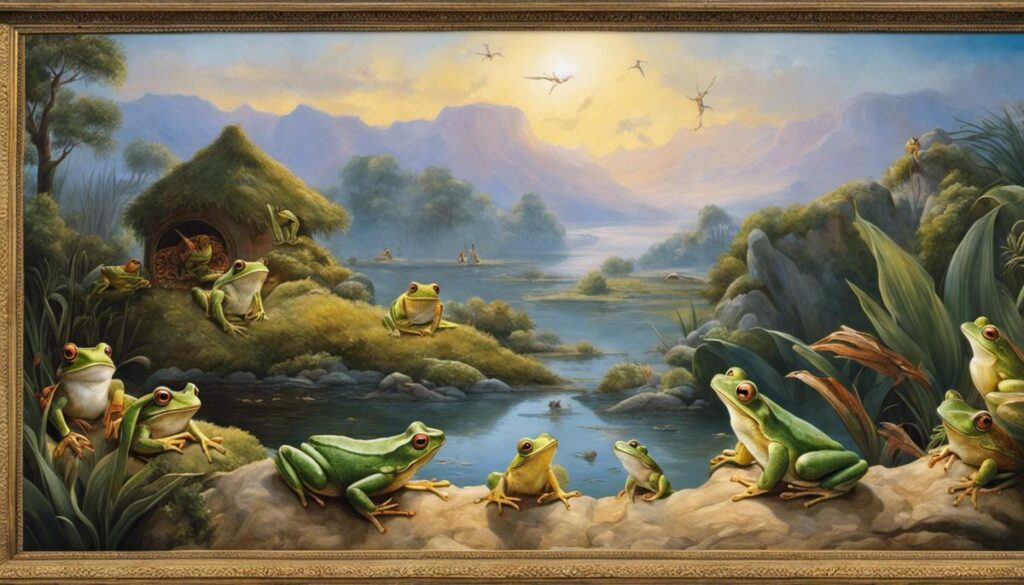Evocative and enigmatic, dreams have remained a topic of vast intrigue and analysis throughout human history. Elements that feature prominently in dreams, such as frogs, often carry a wealth of meaning intricately connected with cultural, religious, and personal symbols and themes. The interpretation or understanding of such symbols can often help individuals generate significant insight into their lives. While many cultural anecdotes, religious manuscripts, and dream psychology all have various interpretations of these unique amphibians, this discussion will be centered on the significance of frogs within a biblically symbolic framework and general dream analysis. The objective is to traverse the realms of the biblical text, psychology, culture, and individual experiences to create a comprehensive understanding of the meaning of frogs in dreams.
Biblical Context of Frogs
Anuran Analogies: A Study On The Biblical Portrayals Of Frogs
Decades of exegetical studies reveal that the symbolism of particular animals in the Bible offers intriguing insights into the worldview of ancient civilizations. From the steadfast loyalty of dogs to the wisdom of serpents, each creature occupies a niche in the broad tapestry of symbolic understanding. This discourse will focus on an often-overlooked subset of the animal kingdom – the frog – and its biblical representations.
Frogs emerge in two distinct narratives within the Bible, specifically in the Book of Exodus and the Book of Revelation, serving as illustrative devices to clarify two essential theological messages: judgment and transformation.
In the Book of Exodus, frogs become a dominant symbol of divine plagues. Exodus 8:2-14 recounts the second of the ten plagues inflicted upon Egypt, where God instructed Moses to stretch out his hand over the waters of Egypt to bring forth frogs. These amphibians inundated homes, beds, kitchens, ovens, and kneading bowls, foreshadowing God’s judgment. In this context, frogs become an augury of discomfort, disruption, and divine judgment upon the iniquitous.
Contrarily, the Book of Revelation, specifically Revelation 16:13-14, endorses frogs as symbolic of manipulative spirits that could alter the perceptions of kings and the masses. This narrative presents frogs as agents of deception that lead astray the unfaithful towards the catastrophic ‘Battle of Armageddon’. The eschatological outlook portrays frogs as critical instruments of a great spiritual war between truth and facade.
The dichotomy of these two biblical interpretations of frogs highlights the dynamism of symbolism in ancient texts. It also emphasizes the erroneous nature of a simple, unidirectional understanding of symbolism.
In conclusion, the biblical representation of frogs—though sparse—is as multifaceted and profound as that of other, more frequently cited, animals. As much as they signify discomfort, disruption, and divine judgment, frogs also serve as powerful symbols of deceit and false perception, acting as catalysts inciting significant biblical events. These representations enrich our understanding of how the original Bible readers viewed the world around them, showing a level of sophistication and subtlety that continues to resonate in biblical interpretations and translations today. Through the lens of bio-symbolism, we glean a deeper understanding of the intricate tapestry of the human-animal relationship within the religious and cultural milieu of the early biblical period.
The Bible is an old testament to man’s relationship with nature—juxtaposing awe, reverence, fear, and understanding—a relationship that not only characterizes mankind’s past but continues to define the existential predicament of the Anthropocene in the present. Reading between the lines and discerning the nuanced apparels of symbolism, including those of frogs, help us appreciate the Bible’s nuanced dialogue with nature, that still echoes our environmental ethos today.
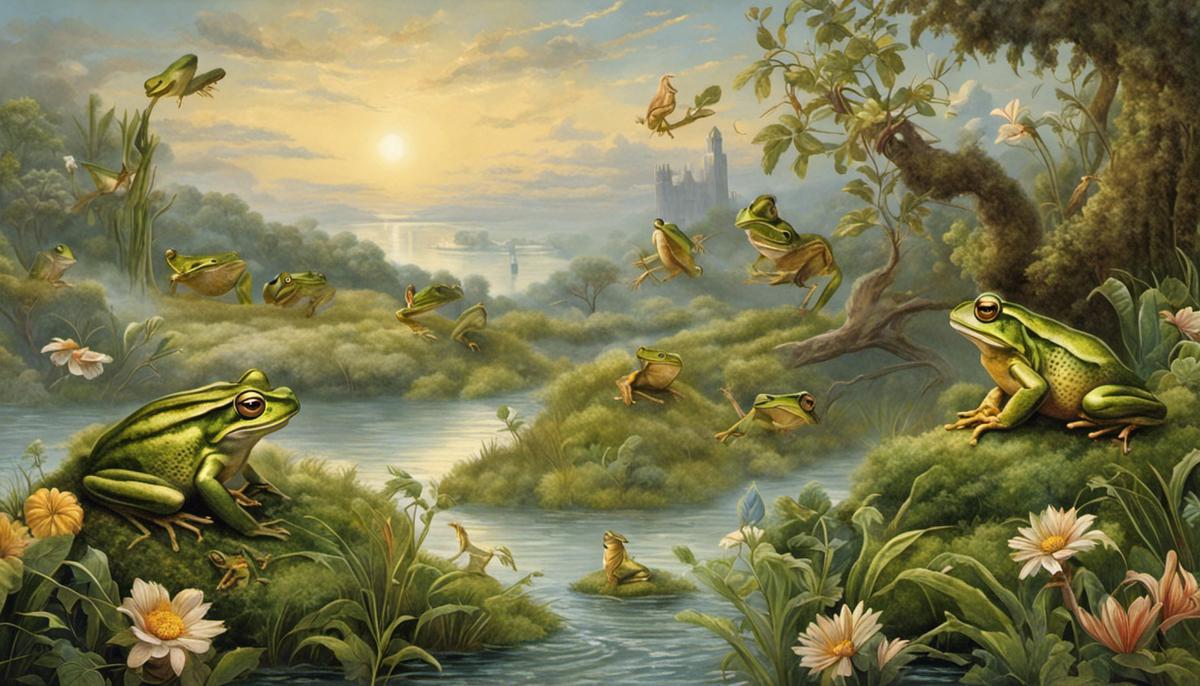
Symbolism of Frogs in General Dream Analysis
Frogs as Symbolic Elements in Dream Interpretation: A Psychological and Cultural Perspective
In the realm of dream interpretation, the symbol of a frog often points to a sequence of life changes. These amphibians, possessing a unique life cycle, frequently symbolize transformation, as they seamlessly transition from aquatic tadpoles to terrestrial adults. As such, when frogs appear in dreams, they can signify impending changes, growth, and adaptability.
From a psychological perspective, the presence of frogs in dreams often connects with deep-seated feelings and thoughts about renewal and rebirth. Carl Jung, a renowned psychologist well-versed in the interpretation of dreams, suggests that frogs can be representations of the unconscious mind – a testament to their association with water, a universally accepted symbol of the subconscious. In this context, dreams about frogs may be regarded as an invitation to introspect, unearth unconscious desires, or confront repressed issues.
At the intersection of psychoanalysis and cultural studies, dream translation has often borrowed symbols from global mythologies. Pervading multiple cultures, the depiction of frogs in various mythologies associates them with themes of fertility, prosperity, and the cyclic nature of life. In Native American traditions, for instance, frogs are regarded as bringers of rain and are thus linked with life-giving water. Similarly, in Celtic lore, frogs often symbolize healing powers and renewal, which will have direct implications on the interpretation of dreams where these creatures appear.
Additionally, the role of a frog in a dream can also be informed by its biological characteristics. Frogs are creatures capable of living in two realms–water and earth, indicative of flexibility and adaptability. Hence, a frog appearing in a dream could be suggesting the necessity of adaptability or an encouragement to embrace change, reflecting the unique ability of the dreamer to navigate through different scenarios or stages in life.
The specific action of the frog within the dream might also influence its symbolism. If the dream features the frog leaping, this might suggest a leap of faith or unexpected progress in the dreamer’s real life. Conversely, a still or silent frog could symbolize a period of waiting or the need for patience.
Taking the same meticulous approach in semantic analysis applied to biblical texts, these symbols in dreams should not be isolated from the context. Careful consideration of the whole narrative thread of the dream, the individual’s personal associations with frogs, and their current life circumstances contribute to a more accurate and detailed interpretation.
Suffice to say that the interpretation of frogs in dreams, like in ancient biblical narratives, involves complex symbology surpassing simplistic translations. As efficient encapsulations of arcane wisdom and universal human experiences, these amphibious creatures can share insightful narratives about our inner thoughts, catapulting our understanding of the psyche to new dimensions.
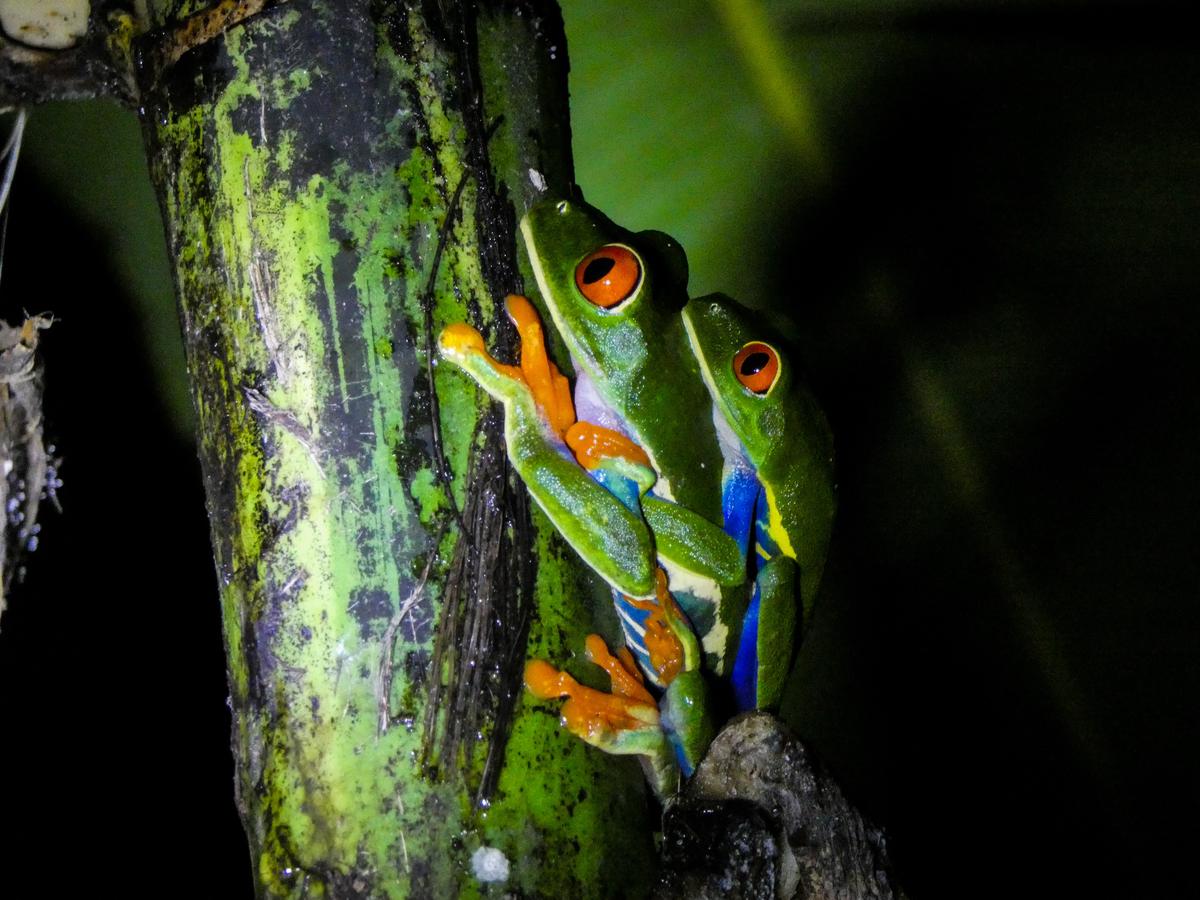
Integrating Biblical and Psychological Interpretation of Frogs in Dreams
The integration of biblical and general dream interpretations of frogs offers a captivating exploration into ancient beliefs and human psychology. The frog, as a creature adept at navigating both terrestrial and aquatic realms, has aroused fascination in various cultures and traditions. This unique amphibian, with its transformative life cycle, has inspired a wealth of symbolism, both in dreams and religious texts, which combines to create a rich tapestry of interpretations.
In biblical narratives, as previously discussed, frogs are primarily symbols of divine judgment and deception. Screening this imagery through the lens of dream interpretation reveals intriguing parallels and contrasts, giving rise to novel interpretations.
Highly significant in dream interpretation, frogs often symbolize transformation and change. As amphibians that undergo significant metamorphosis from tadpoles to fully developed adults, they symbolize a sense of evolution, renewal, and rebirth. This allows one to weave connections between religious texts and dreams, creating an intricate network of symbolism where frogs function as precursors to change and self-realization.
The fascinating dimension of these amphibians’ biological characteristics lends itself to broad interpretations within dream symbolism. Frogs are celebrated for their adaptability and flexibility – apt at thriving both on land and in water, thereby symbolizing one’s ability to navigate through complex situations and adapt to changes effectively.
In considering the actions of the frog within a dream, one can further dissect the symbolism it portrays. A leaping frog may reflect ambitious leaps of faith or significant changes on the horizon, while a still frog may suggest a period of introspection and waiting. These interpretations may provide a potential bridge between the biblical and psychological dimensions of frog symbolism; the consequences of deceptive ideologies, as suggested in the bible, could lead to periods of introspection symbolized by a stationary frog in dreams.
Personal and cultural associations indeed influence the interpretation of frog symbols within dreams. These amphibians hold various connotations in different cultures and traditions. For instance, in many indigenous cultures, frogs are symbols of fertility and abundance due to their association with water and rain.
The potent symbolism of frogs exemplifies the importance of a nuanced interpretation of nature within both dreams and biblical narratives. In dreams, frogs often mirror personal experiences and emotions, reflecting aspects of transformation, adaptability, and personal growth.
As one meanders through the labyrinth of biblical and dream interpretations of frogs, it is clear that both domains deploy nature-based symbolism to invoke deeper insights into human experiences. Emphasizing the importance of context, personal associations, life circumstances, and cultural perspectives fosters a rich dialogue between the domains of religion, psychology, and nature, enhancing our understanding of the intricate human psyche and its interactions with the natural world.
Exploring frog symbolism as an integrated narrative woven between dream and biblical interpretations encourages consideration of the interconnectedness of human experiences across ages. This enriching dialogue bridges the gap between the ancient and contemporary, creating a mutual discourse that delves deep into the realm of symbols, man, and nature, sparked by the humble frog.
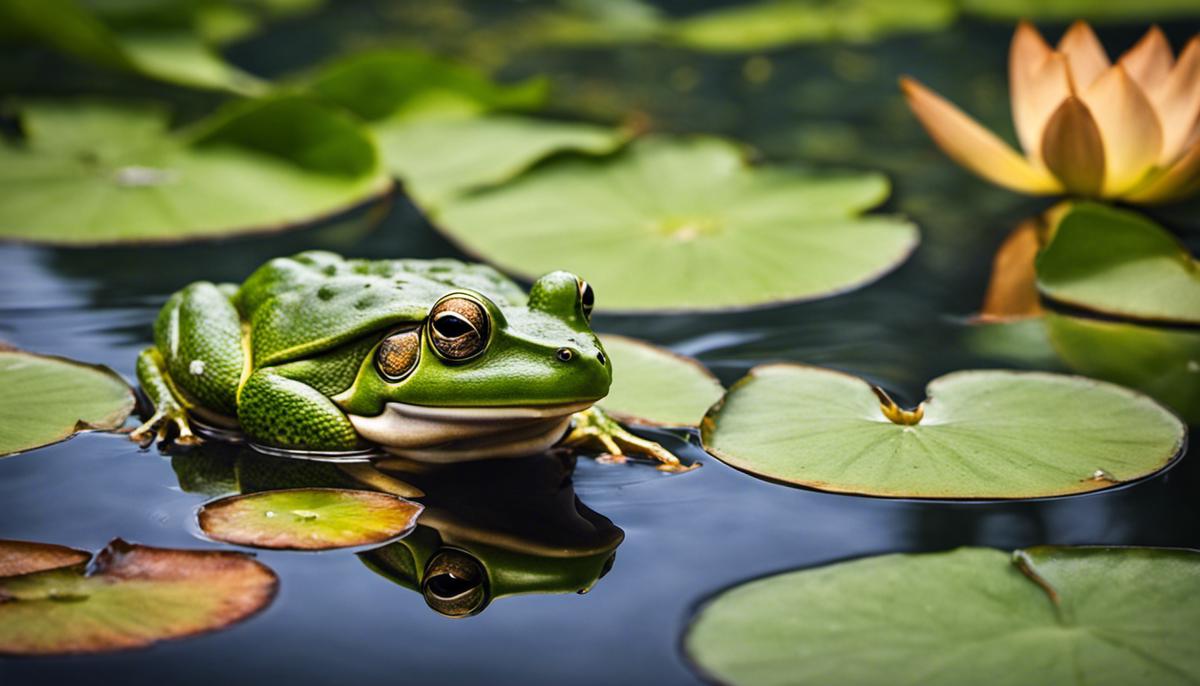
Case Studies: Interpretation of Frogs in Dreams
Amplifying the interpretation of frogs in dreams as evident symbols of change and transformation, we tread into the illustrative case study of Aztec mythology. To the Aztecs, as Anawalt (1987) mentions in her study on Aztec symbolism, frogs served as a symbol of growth and continued life cycle due to their metamorphosis from tadpoles into frogs — a striking parallel to the human trajectory of birth, life, and death. This Aztec symbolism of frogs has carried over into the interpretations of dreams, with many Aztecs and their descendants viewing dreams of frogs as indications of personal growth or expansion awaiting the dreamer.
Moreover, beyond the boundaries of the western cultures, frogs carry a unique symbolism in various Oriental cultures, too. For instance, in traditional Chinese culture, a dream of a frog is often interpreted as a sign of prosperity and good fortune (Wu, 2012). Even the utterance of the word ‘frog’ in Mandarin, ‘wa’, sounds similar to the word for ‘baby’, providing a fascinating linguistic perspective into the significance of frog dreams in China, suggesting fertility and familial abundance.
Moving into modern times, notable psychologist and founder of analytical psychology, Carl Gustav Jung, positioned animals in dreams as representations of fundamental aspects of the human psyche (Jung, 1964). Frogs, given their unique life cycle of metamorphosis and their ability to dwell both on land and in water, were seen by Jung as powerful symbols of the unconscious, particularly in terms of transformation and adaptability. Thus, a dream of a frog might be interpreted in the Jungian perspective as an indication of upcoming personal transformation or a need to adapt to changing circumstances, further echoing biblical and traditional narratives discussed earlier – an intriguing correlation considering the vast temporal and cultural gap.
In contemporary dream psychology, popular theorists like Fritz Perls view dream frogs as potential signs of emotions or experiences that the dreamer is seeking to let go or leap away from, given the frog’s ability to jump (Perls, 1969). An interesting case from Perls’ work involved a woman who experienced recurring dreams of a large frog. As they traversed the interpretive journey together, they uncovered that the frog represented stagnation she was feeling in her personal life and couched a latent drive to leap forward towards her ambitions, mirroring Perls’ interpretation of frog symbolism in dreams.
In studying these varied interpretations across different fields and societies, one may glean a glimpse of the profound intangible bond shared by humans and nature, its manifestations etched deeply into our very cognition and dreams. It underscores the power and versatility of symbols, an omnipresent, potent language transcending time, speaking volumes about our individual experiences, collective consciousness, and our ever-evolving dialogue with the natural world. Through the study of dreams and animal symbolism such as that of frogs, we gain insights not only into our psyche but also into our history, our culture, and our inherent connection with the world around us.
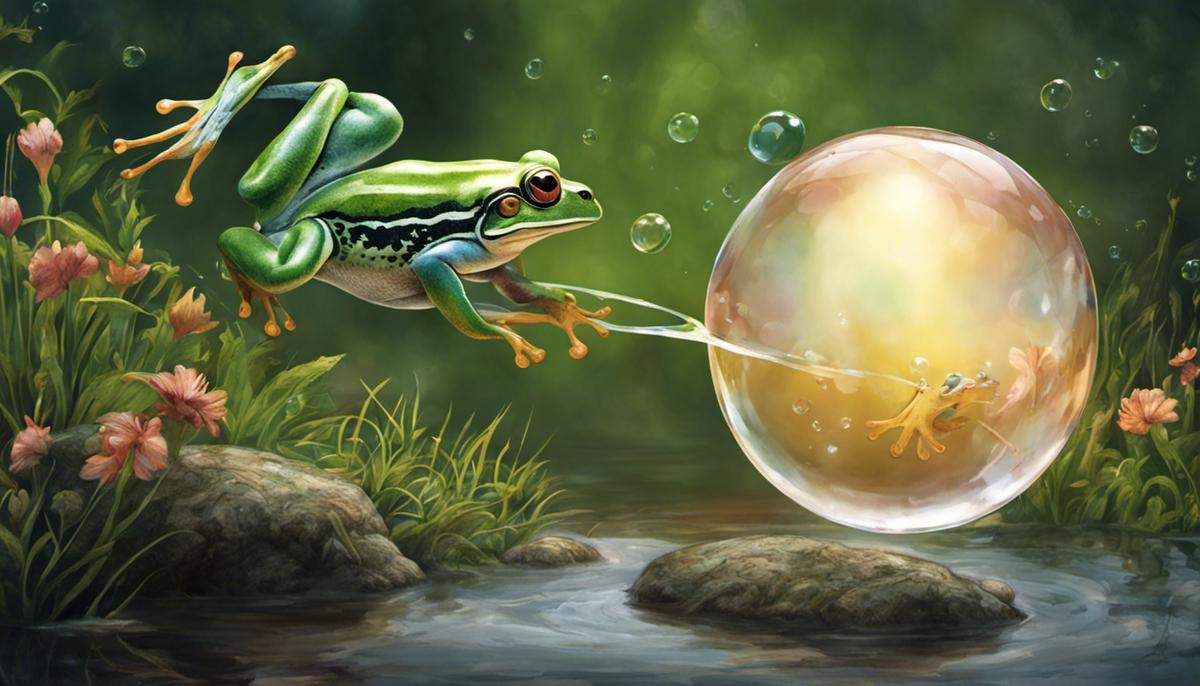
The Influence of Culture and Religion on Dream Interpretation
Delving into the folds of cultural interpretation, it is interesting to discern how divergent cultural perspectives transform and shape the interpretations of frog symbolism in dreams. When exploring Aztec symbolism, we find frogs to take on positive connotations. Stemming from their cyclical lifecycle behaviors, frogs symbolize growth and continuity in this context, indicative of personal growth or expansion while dreaming.
The Chinese culture, historically steeped in rich symbolism and verse, similarly associates the frog with auspice and good fortune. Pythagoreans, the followers of Pythagoras who deeply intertwined numerical symbology with philosophical teachings, saw the frog as symbolic of harmony due to the animal’s amphibious nature – dwelling in water and on land as an emblem of balance.
The revered psychologist Carl Gustav Jung, whose work underlines the interpretational aspects of this discourse, opined that animals appearing in dreams symbolize cardinal aspects of the human psyche. For Jung, the frog was representative of transformation, given this species’ amphibian ability to transition from aquatic tadpole to terrestrial adult – a powerful symbol of adaptability and change.
Fritz Perls, a psychoanalyst and psychiatrist known for developing Gestalt therapy, offered a subtly differing perspective on dream frogs. He positioned these symbolisms as indicators of deep-seated emotions or experiences that the dreamer wishes to release or distance themselves from. This process of ‘ejection’ or ‘moving away’ is characteristic to symbolic transformation connected to frogs in dreams, encapsulating the idea of letting go to invite metamorphosis.
In conclusion, it is evident that the profound bond between humans and nature transcends into our subconscious and colors our dreams with rich symbolism. A singular natural element – the frog in this instance – can harbor a multitude of meanings, each intertwined with cultural frames of reference, religious beliefs, and even personal life circumstances. Akin to how our dreams open a window into our psyche, understanding these diverse interpretations can unravel layers of our collective human experience, bridging gaps between ancient symbols and contemporary understanding. This intricate interplay reveals not just our connection to nature, but our shared human journey through the symbiotic prism of man and nature. Utilizing nature as a metaphoric landscape, as done in dream interpretations, we can redefine and discover the diversity and richness of human experiences across different cultural and historical folios.
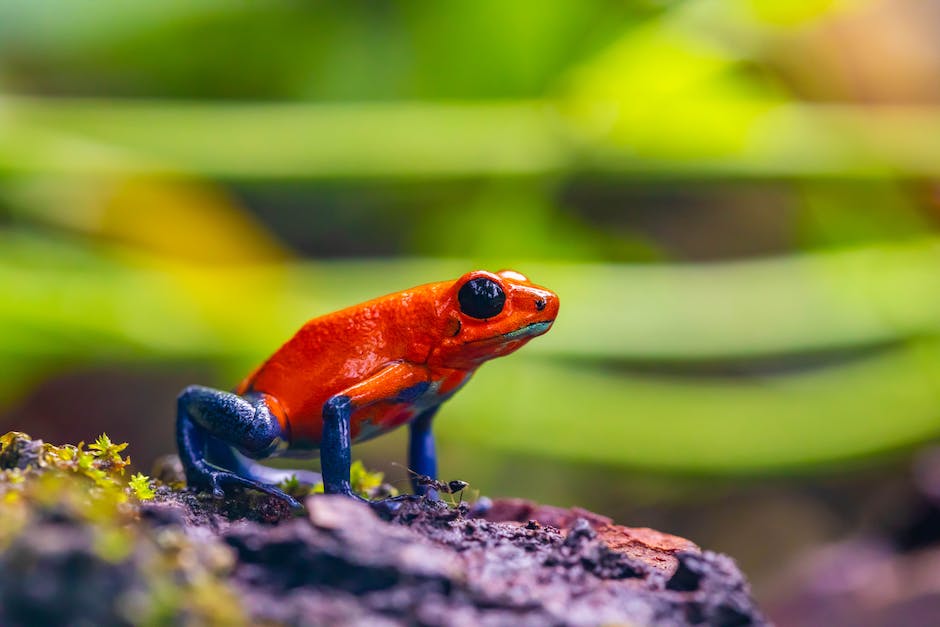
From this exploration, it becomes evident that the interpretation of frogs in dreams cannot be universally dictated due to the multitude of symbolic messages intertwined in religious texts, psychological interpretations, cultural narratives, and personal experiences. Even within the biblical context, frogs can be symbolic of both positive renewal and negative plague, depending on the circumstances. Additionally, the depth of psychological analysis and cultural interpretation amplifies the multifaceted symbolism associated with frogs appearing in dreams. This multifaceted interpretation further corroborates the inherent subjectivity of dream analysis and its contextual dependence. The study ultimately reiterates the importance of personal belief systems, sociocultural values, and spiritual interpretations in decoding the meaning of such vivid dreams.

